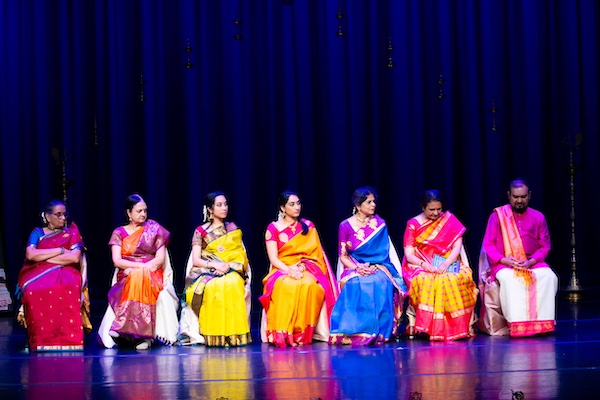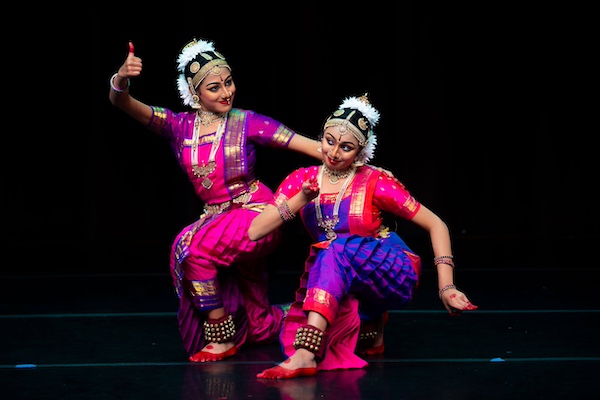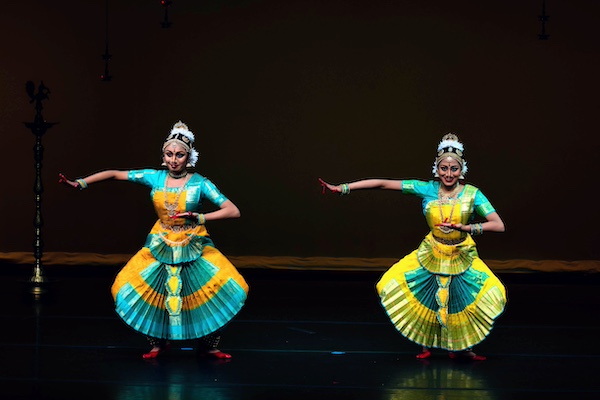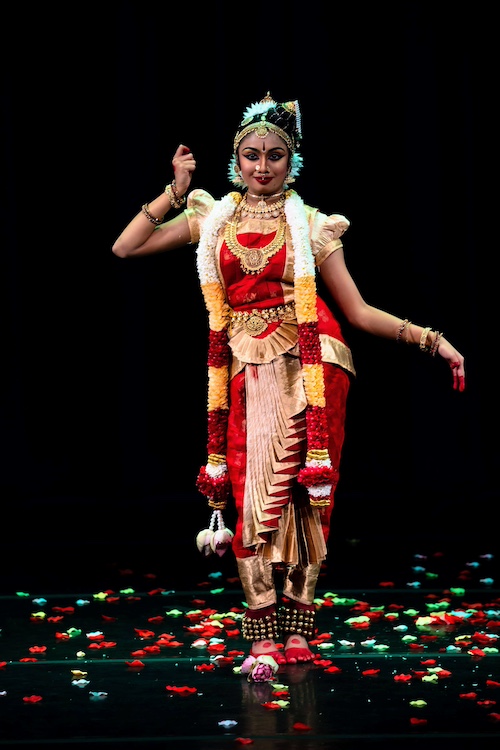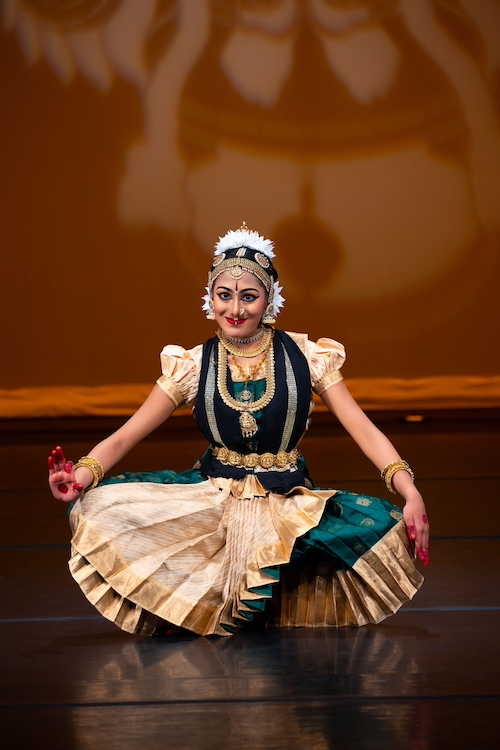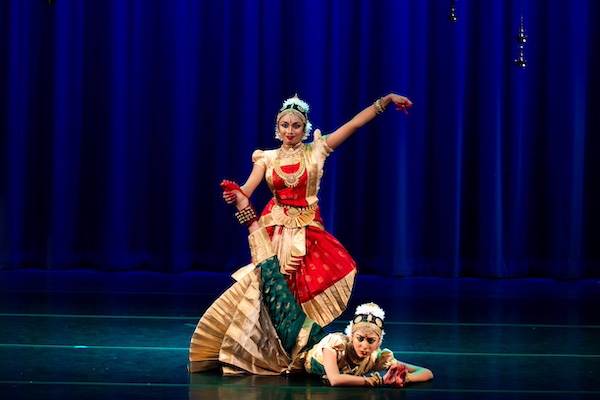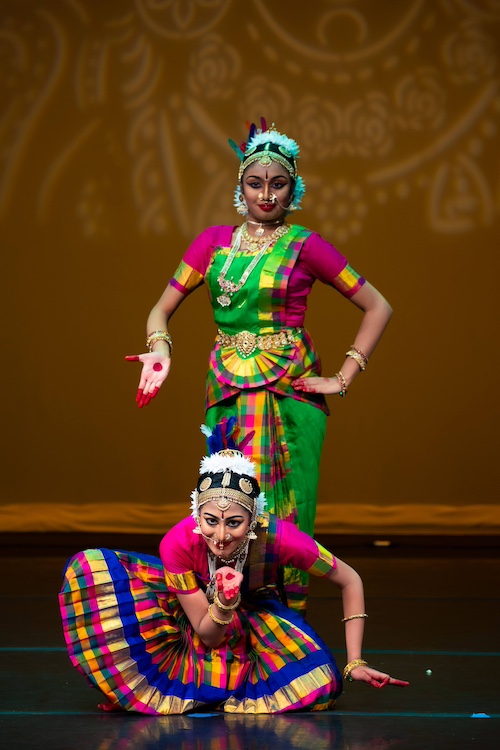Contribute
| Arangetram: Aarya Pillai And Hiranmayi Lalithkumar |
Amrutha Ananth
09/04/2025
In Perfect Harmony: A Duo Arangetram by Aarya Pillai and Hiranmayi Lalithkumar Written by Amrutha Ananth When two dancers shaped by the same guru share the stage, it becomes more than a formal debut—it transforms into an artistic journey of shared foundations and distinct voices, where common training blossoms into complementary interpretations. At their recent arangetram, Aarya Pillai and Hiranmayi Lalithkumar, disciples of Acharya Pooja Kumar Shyam, brought this rare confluence to life, offering an evening that was both a tribute to the sacred tradition of Bharatanatyam and a vibrant testament to youthful energy, precision, and storytelling. As Master of Ceremony Saritha Venkatesh observed, one could not help but recall the iconic pairing of Vyjayanthimala and Padmini in Vanjikottai Valiban—two artists moving in perfect balance, not in competition but in complement. Their stage presence reflected not only years of rigorous training but also the unfolding of their individual artistic identities; and while their movements often aligned seamlessly, subtle variations in expression, stylistic inflection, and interpretive choices underscored that Bharatanatyam’s vitality lies equally in individuality and symmetry. The recital commenced with a Pushpanjali in Charukesi rāgam, set to the Sankeerna Chaapu tālam, a rhythm cycle known for its intricacy. With its 9-beat pattern, Sankeernam demands an internalized sense of timing—balancing asymmetry with grace, offering little space for error, and calling for exacting coordination. Charukesi’s emotive core—pleading yet sweet—set the tone for the evening. The traditional Kalakshetra-style namaskaram that opened the piece was both a prayer and an assertion of lineage. Right from the beginning, the choreography established the theme of unison. As the line echoed “tham tham thajam dheem dheem dheem thajam…”, a remarkable choreographic moment had one dancer extend a mudra mid-jathi while the other completed it—this kind of mirrored movement demanded immense awareness, breath control, and silent communication. It wasn’t just technically impressive but spiritually resonant—an invocation to dance as one body, one soul. The transition into "Vizhikku Thunai" from Kandar Alankaram, a composition by Saint Arunagiri in praise of Muruga, marked a shift from pure movement to expressive storytelling. Verse 17 was performed by Aarya, and verse 38 was beautifully rendered by Hiranmayi. The verses, an appeal to Muruga to protect one’s inner and outer vision, explore the transformative power of divine grace. I’ve always loved hearing this piece sung by the duo Ranjani-Gayatri—and seeing Aarya and Hiranmayi bring it to life through dance made it all the more special, as if the music found its visual echo on stage. The choreography was fluid and symbolic—the concept of divinity as both protector and beloved was tenderly explored. The end pose was striking, casting Hiranmayi as the majestic peacock and Aarya as Muruga. Arthi Kumar Angl’s voice was not just a backdrop but an emotive guide that steered the abhinaya with depth. Guru Durga Krishnan’s veena lent a maternal softness, while Guru Tara Anand’s violin delicately followed the emotional graph. Sri Toronto Gowrishanker Balachandran’s mridangam maintained a meditative pulse—never overpowering, always listening. Intensity escalated in the Narasimha Kauthuvam, a ragamalika in Adi tālam, composed by G. Gurumurthy. Beginning with portrayals of the Dashavataram, Hiranmayi transitioned from Matsya to Kalki with remarkable sharpness, each incarnation etched in movement and mood. Blue lighting suggested the cosmic ocean—serene, yet brimming with latent energy. When she reached the climax with the arrival of Narasimha, the stage transformed—bathed in golden-yellow light, echoing the avatar’s fiery presence. The crescendo, “Lakshmi Narasimha Mama Deva Karavalambam”, became not just a chant but a call for divine protection, resonating with urgency and surrender. And then came the invocation—“Om Narasimhaya Namaste Namaste.” Hiranmayi didn’t bow. She stood rooted, her stance expanding with authority, fingers curled into a Simhamukha mudra. Her torso trembled with a force barely contained, her eyes flared with controlled rage, piercing through the imagined presence of Hiranyakashipu. Each namaste wasn’t a gesture of submission—it was a declaration of awe, a salute to a force beyond comprehension. Her hands tore through the air in arcs of divine retribution, and in that instant, devotion, fury, and righteousness coalesced. This was dramatized philosophy at its finest—a searing visual metaphor for justice, protection, and grace held in perfect tension. The mood lightened with a Jathiswaram in Vachaspati rāgam. This expansive and uplifting rāgam perfectly framed the return to technical rigor, in a choreography by Smt. Savithri Jagannatha Rao, one of Pooja’s revered gurus. The korvai sequence beginning with “NiDaPa” was executed with sharp synchrony. Though devoid of lyrics, the piece demanded emotive nritta—and Aarya and Hiranmayi brought sparkle and joy to each step. Guru Tara Anand’s violin led the musical dialogue, dancing alongside their footwork, while the mridangam stitched the piece together with crisp rhythmic clarity. From this burst of rhythmic energy, the recital transitioned into a more evocative register. The recital continued with the Muruga Shabdam, a captivating ragamalika set to Misra Chapu, originally composed by Semanar Koil Shanmugam. Though initially tuned in a folk idiom, it was later refined into classical form by Madurai T. Sethuraman and popularized through the evocative choreography of Sri V.P. Dhananjayan. This piece holds a special place in my heart—it was the very first shabdam I learnt and performed. The story behind its transformation and revival was lovingly shared with me by my own teacher, a disciple of the Dhananjayans. That spiritual lineage felt vibrantly present on stage. The poignant lyrics—“Thandai Muzhanga Salangai Kulunga Thavazhnthu Varum Muruga” and “Tamil Thalattu Paattil Nil Kuzhandaiyai Yen Mun Thavi Varum Muruga”—trace Lord Muruga’s journey from an anklet-clad infant crawling to the rhythm of jingling bells, to a radiant youth destined for his union with Valli. Aarya and Hiranmayi brought this progression to life with both tenderness and quiet strength, each stanza unfolding a new chapter in the divine narrative. Their portrayal seamlessly blended expressive abhinaya with controlled nritta, honoring the spirit of the original choreography while infusing it with personal grace. A particularly endearing moment stood out in Pooja’s choreographic interpretation of this piece: as Muruga, Aarya called out to his peacock—Hiranmayi—who responded with playful elegance. It was so natural and sweet! That little exchange, almost like a whispered secret between friends, brought a rare lightness and joy to the performance. Guru Dakshina, in Tilang rāgam, composed by Aarya’s grandfather, Shri T.S.N. Nair, was a deeply personal solo offering by Aarya to Lord Guruvayoorappan. Beginning with the Shanthakaaram Bhujaga Shayanam viruttam, the piece radiated serenity. What followed was a lyrical tracing of Krishna’s life—from playful Balakrishna to the divine protector. The highlight was Gajendra Moksham—the helpless elephant, trapped in a crocodile’s grip, trumpeting its despair. Aarya’s portrayal was masterful—her body writhing in panic, her face etched with fear, until the divine descended. The moment of Vishnu’s arrival was quiet, yet thunderous in its emotional impact—Aarya’s posture, open-armed and lifted in surrender, evoked both relief and reverence. The accompanying music, especially the veena and violin, surged in pace and intensity, mimicking Garuda’s flight, before melting into calm at the moment of divine deliverance. This piece was not just devotional—it was deeply spiritual and soul-stirring. The Varnam – Swami Naan Undan Adimai, in Nattakurunji rāgam and set to Adi tālam, stood as the evening’s emotional and technical fulcrum—an intricate tapestry of bhakti, precision, and dramatic flair. Choreographed by Acharya Pooja Kumar Shyam, this piece went far beyond being a test of endurance; it was an odyssey of narrative immersion and artistic conviction. The central motif of servitude to the divine wove through every jathi and abhinaya sequence, demanding both vulnerability and virtuosity from the performers. The trikala jathi was crafted like a vignette, unique in rhythm and texture. In one sequence, footwork echoed like cascading beads, as the dancers held deep muzhumandi postures in stillness before springing into araimandi, their silhouettes etched sharply against the stage lights. The rhythmic syllables “thath tha gethi tha”, accompanied by gestures in alapadmam and katakamukha, were executed with precise leg swings—delicate yet firm, like a bell that does not waver despite the tremor. Another jathi, punctuated by the mnemonic "tha hatha jam thari tha," was striking in its spatial innovation: the dancers faced away from each other, yet moved in perfect rhythmic sync—a subtle allusion to individuality within shared surrender. The Kannappa Nayanar sanchari was particularly captivating. Hiranmayi, in the role of the tribal devotee, delivered a powerful portrayal—her act of plucking out her eye held neither melodrama nor hesitation. It was raw, visceral, and beautiful. The tension in her jaw, the resolute arc of her arms, and the slow descent to the floor had the audience holding their breath. In the Markandeya sanchari, Aarya as Shiva was a picture of composed divinity—undaunted, unblinking—as Yama, portrayed by Hiranmayi, prowled ominously. Their interactions were shaded with refinement. The lighting, curated by Athipathy Pandy, turned from deep blue to vermillion at the moment of divine intervention, as the chant “Nataraja Deva Sachidananda” filled the air. For a moment, the audience seemed suspended in that ether between time and eternity, as the visage of Shiva flickered into being. The second half opened with the luminous Gauri Manoharam, composed in Gauri Manohari rāgam by Shri T.S.N. Nair. What struck the creative eye first was the visual palette: Hiranmayi clad in deep vermillion red with antique gold, and Aarya in a lustrous emerald green with burnished gold. The complementary hues evoked Agni and Prithvi, Laya and Lasya, Shiva and Shakti—opposite forces that ignite and soothe, destroy and protect. Whether intentional or not, the color contrast mirrored the choreography’s emotional arc—the descent of Ganga, the celestial friction of masculine and feminine forces, and the moment of eventual harmony. Particularly striking was the stanza with lines ending in “am” – DamaruNadham, Swaroopam, Vatsalam, Karanam – employing the poetic device of terminal assonance. The recurring vowel sounds lent a lyrical cadence to the verse, echoing through the dancers’ transitions from brisk, dynamic sequences to moments of poised stillness, as if the cosmos itself were pausing to exhale between syllables. The next piece, Nachiyar Thirumozhi – Vaaranam Aayiram, Andal’s evocative dreamscape brought to life with grace and devotion by Hiranmayi. She moved seamlessly from abstract emotion to tangible experience, portraying Andal’s yearning for union with Lord Ranganatha through the delicate staging of a traditional Tamil wedding. From the drape of the saree to the sway of the garlands, every detail felt lovingly chosen. The ritualistic choreography—offering the garland, placing the turmeric thread, locking eyes across imagined thresholds—was dignified and tender. The line “Kana Kanden” (I saw Him) became a visual sculpture: Hiranmayi froze mid-movement, eyes wide and luminous, her body echoing the timeless stillness of bronze temple idols. As the piece moved toward its climax in Villiputhur, petals floated onto the stage—a subtle, divine benediction. The wedding of Kodhai Devi and Vishnu unfolded not as performance, but as anubhava—an experience. It was devotional storytelling at its most transcendent, where choreography became prayer, and movement, memory. The philosophical Appan Avataritta Katamrittam, set in the profound Kharaharapriya ragam and composed by Papanasam Sivan, was a moving homage to Lord Sastha. With refined grace and intensity, Aarya embodied the many dimensions of the deity—shifting seamlessly from the fierce protector in the form of ‘Shakthi’ to the beguiling enchantress ‘Mohini’, capturing the complexity of divine balance. The culminating ascent to Sabarimala was nothing short of transcendental; as Aarya delicately mimed the opening of the sanctum doors, a radiant image of Ayyappa illuminated the backdrop, bathing the stage in sacred light. The symbolic irumudi gesture, paired with the fervent chant of “Sharanam Ayyappa,” transformed the auditorium into a living temple, where spectators felt the palpable presence of the divine. Aarya’s command over abhinaya and nritta elevated the piece, revealing her maturity as a dancer capable of channeling both spiritual depth and technical precision. The Thillana in Nagaswaravali rāgam, composed by the illustrious Lalgudi Jayaraman, injected the recital with an invigorating burst of rhythmic vitality and expressive nuance. While many are familiar with the iconic Oothukadu Venkata Kavi’s Kalinga Narthana Thillana—a classical staple depicting Lord Krishna’s divine triumph over the serpent Kalinga—this rendition stood out for its inventive reinterpretation and masterful execution. The story of Krishna subduing Kalinga is more than myth; it symbolizes the victory of dharma over adharma, light over darkness, and divine will over chaos. Aarya and Hiranmayi displayed exceptional versatility and seamless coordination as they embodied both Krishna and the mighty serpent, dynamically switching roles mid-performance with remarkable fluidity. This role exchange is a sophisticated choreographic device that challenges the dancers to not only master contrasting physicalities—Krishna’s playful grace and Kalinga’s serpentine menace—but also to sustain the emotional intensity and narrative clarity across rapid transitions. Their footwork was crisp and lightning-quick, the adavus executed with razor-sharp precision, yet never losing the natural flow of the rāgam’s lilting melody. The interplay between the two performers demonstrated a rare blend of technical rigor and emotive storytelling—each gesture, glance, and posture a testament to their deep understanding of the mythos and their guru’s vision. The final tableau, where Krishna stands victorious atop the subdued serpent, arms raised in a triumphant yet playful gesture, was a powerful visual crescendo. The moment was met with sustained applause, a recognition not only of the narrative’s timeless appeal but of the extraordinary skill and artistry with which Aarya and Hiranmayi brought it to life—transforming a familiar story into a vibrant, living experience. The evening concluded on a deeply spiritual and joyous note with Brahmam Okate, set in the vibrant Bowli rāgam—a fusion of classical and folk rhythms that beautifully expresses the universal truth of oneness. Popularized by Sudha Raghunathan and composed by Annamacharya, the piece proclaims “Brahmam Okate” — there is only one supreme God. The lyrics affirm that regardless of caste, status, or species, the divine spirit within all beings is the same. From shared experiences like sleep and pleasure to the impartial sun that shines on all, the song celebrates unity in diversity. The sacred name of Sri Venkateshwara underscores this all-encompassing oneness. On stage, Aarya and Hiranmayi embodied this message with vibrant energy and graceful expression. Their colorful costumes and lively choreography captured the spirit of festive village celebrations, inviting the audience to join in a communal dance of devotion. Through synchronized steps and meaningful gestures, they conveyed that divinity transcends all forms and differences. Their performance turned this timeless truth into a heartfelt experience, closing the evening with a joyous and prayerful celebration of unity. While each member of the orchestra—Acharya Pooja Kumar Shyam on the nattuvangam, Arthi Kumar Angl on vocals, Guru Durga Krishnan on veena, Guru Tara Anand on violin, and Sri Toronto Gowrishanker Balachandran on mridangam—is a seasoned artist in their own right, it is truly commendable how they brought their mastery with such sensitivity and dedication, shaping the stage into a nurturing space for these rising stars. Beyond technique and storytelling, Aarya and Hiranmayi delivered a spiritual experience that transcended the stage, reminding us that true art is devotion made visible. The spotlight may have dimmed, but the space they carved in the audience’s hearts remains illuminated—an enduring glow that promises a bright and inspiring journey ahead for these two remarkable artists.
You may also access this article through our web-site http://www.lokvani.com/

